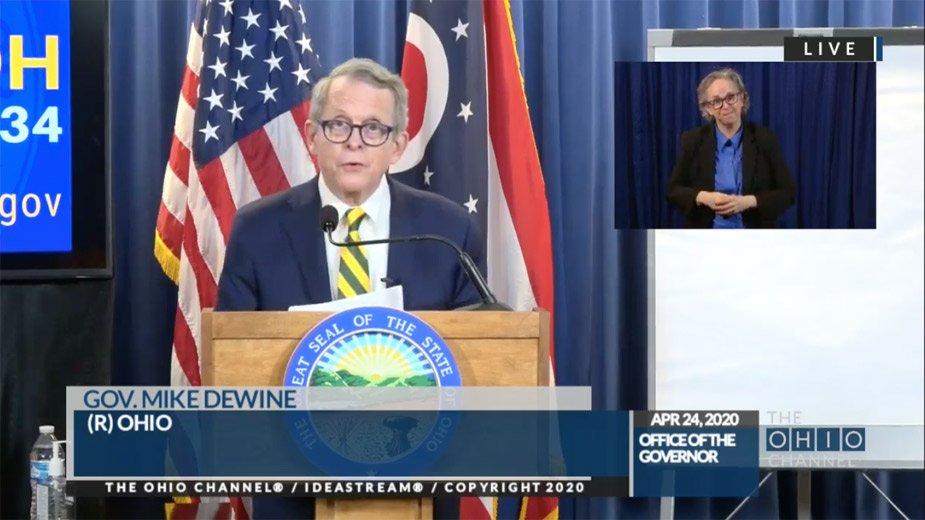With Partners Ready, Ohio Testing Capacity to Rise in Coming Weeks
YOUNGSTOWN, Ohio – Partnerships with two companies with a presence in Ohio will help the state expand COVID-19 testing to 22,000 per day by the end of May.
In his daily briefing Friday, Gov. Mike DeWine announced that Roe Dental Lab in Independence has worked with the Ohio Manufacturing Alliance to develop swabs used in COVID-19 testing. The association connected Roe with Formlabs, a 3D printing company in Toledo that previously worked with Ohio State University and Battelle Memorial Institute to develop the swabs.
Once production begins, Roe will be able to produce upward of 1 million swabs per week.
And earlier this week, the Food and Drug Administration approved a new testing reagent made by Thermo Fisher Scientific, which has a site in Columbus. Based in Waltham, Mass., the company employs 1,500 in Ohio, DeWine said.
With the swabs and reagent available, Ohio can ramp up testing to 7,200 per day beginning Wednesday. Currently, the state can test about 3,300 daily, Lt. Gov. Jon Husted said.
As the manufacturers make more and more product, testing capacity will increase to 15,000 per day by May 6, 18,800 per day May 13 and 22,000 by May 27.
“We will have a greater ability to go into nursing homes and do sampling. One of the concerns we all have is congregate settings and certainly nursing homes are an area with a grant deal of concern,” DeWine said. “Second, this capacity will give us a much better capacity to deal with hot spots wherever they occur. Whenever there’s a breakout, we’ll be able to move in and do appropriate testing.”
In addition to the mass testing that will be done to better establish how much of the population has had COVID-19, either with or without symptoms, the testing will be done at congregate sites such as homeless shelters and sites for those with developmental disabilities. Workers, such as those working in grocery stores and manufacturing, will also be able to get tested, the governor said.
The tests will allow the state to better conduct contact tracing, used to determine who a diagnosed patient has been in close contact with and could have transmitted the virus to.
“Contact tracing is one of the strongest weapons we have,” DeWine said. “This will all be done in a voluntary way, but we can take control over this disease. By stopping the spread, we’re protecting others and ourselves. Contact tracing is one tool. It works alongside our other efforts. It doesn’t replace anything. It’s another tool to go along with social distancing, washing our hands and wearing masks.”
Statewide, about 1,700 people will be hired to conduct tracing interviews, said Dr. Mark Hurst, medical director for the Ohio Department of Health. Most of those workers will be employed by local health departments. Already, he said, there is a “substantial volunteer force.”
If a person is diagnosed with COVID-19, a tracer will be in contact to conduct a phone interview to determine where the patient has been and who they may have interacted with. Those who were determined to have close contact will be asked to quarantine for two weeks and check their symptoms and temperature twice daily, reporting those via text to the contact tracers.
So far, Hurst said, most who have been contacted have been cooperative, with only about 10 of some 15,000 diagnosed patients declining the interview.
“Almost all testing right now is clinical and for public health purposes in terms of identifying people who are experiencing COVID-19 and then quarantining them to make sure they don’t spread it to others,” Hurst said. “The surveillance testing that we’re talking about would be in random individuals, using either or both PCR or antibody tests. We really need more and better-developed tests on antibodies. That can give us idea of prevalence in the state of who’s recovered and when we could reach herd immunity, where enough individuals have had the virus or are immune is enough that the risk of substantial spread is greatly reduced.”
While he said that he intends to reveal the full plan Monday of how the Ohio economy will reopen starting May, DeWine and Husted offered some insights for the business community.
“There’s nothing coming that we haven’t seen work on the ground in Ohio. Go back a month. We put in place safety standards based on the best info we had. Businesses have operated safely with those,” Husted said. “We’ve learned since then and have access to new safety precaution. Over the course of the month, the situation on the ground has vastly improved about how you can create a safe workplace. Nothing is coming hasn’t already been effectively used.”
After concerns were raised about businesses being able to procure the safety equipment or cleaning supplies needed to follow the initial practices detailed in the order to reopen businesses, DeWine added that with safety procedures should consist of earnest attempts.
“Any requirement we have is conditioned on people securing items. We hope people make all the due diligence and effort to secure those items,” DeWine said.
Added Husted: “We have the mandate about best practices. If you can take your employees’ temperatures every day, great. But we understand everyone doesn’t have access to things. We’re adding best practices. A mask doesn’t have to be exactly this,” he said, holding up a surgical mask. “It just has to be some sort of face covering that prevents you from discharging things that could land a surface someone touches and then spreads the virus.”
Copyright 2024 The Business Journal, Youngstown, Ohio.



